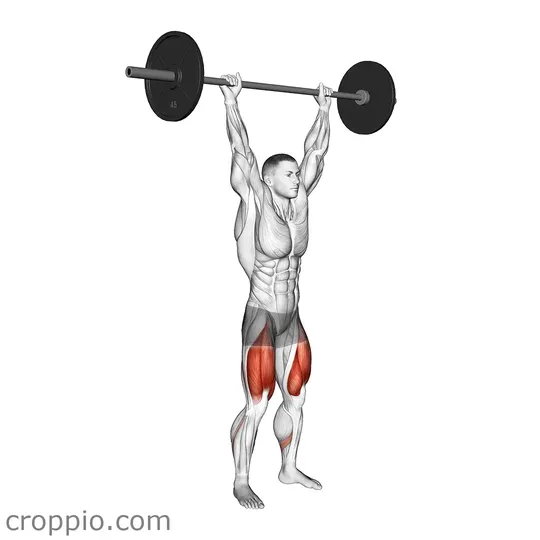Barbell Overhead Squat

Muscles Involved
The barbell overhead squat is a comprehensive compound exercise targeting multiple muscle groups, particularly in the lower and upper body. The primary muscles involved are the quadriceps, gluteus maximus, and hamstrings, which work to stabilize and power the squat movement. The shoulders, specifically the deltoids and rotator cuff muscles, play a crucial role in supporting the overhead position of the barbell. Additionally, the core muscles, including the rectus abdominis, obliques, and erector spinae, are heavily engaged to maintain stability throughout the squat. Secondary muscles involved include the calves, upper back, and lats, which assist in holding the barbell in the correct position.
Top Mistakes
- Allowing the knees to cave inwards during the squat, which can lead to injuries.
- Failing to maintain a neutral spine, resulting in excessive rounding of the back.
- Not fully extending the arms above the head, causing instability in the overhead position.
- Squatting too shallow, which limits the effectiveness of the exercise.
- Using too much weight too soon, leading to poor form and a higher risk of injury.
Execution Tips
- Start with your feet shoulder-width apart and grip the barbell slightly wider than shoulder-width.
- Press the barbell overhead, ensuring your arms are fully extended and engaged.
- Maintain an upright torso as you descend into the squat, pushing your hips back and bending your knees simultaneously.
- Keep your weight distributed evenly across your feet, with emphasis on keeping your heels down.
- Focus on driving your knees outward to prevent them from caving in as you squat lower.
- Exhale and push through your heels to return to the starting position while keeping the barbell stable overhead.
Workouts
The barbell overhead squat can be effectively incorporated into a strength training routine. A suggested structure could include performing 3 to 4 sets of 6 to 8 repetitions, allowing adequate recovery between sets. To further challenge your strength and stability, consider pairing the overhead squat with complementary exercises such as front squats, shoulder presses, or snatch movements. Integrating mobility work and dynamic stretches before the workout will also enhance performance and reduce injury risk.
Conclusion
Incorporating the barbell overhead squat into your fitness regimen offers a multitude of benefits, including improved core stability, enhanced shoulder strength, and greater flexibility in the hips and ankles. This exercise not only develops functional strength but also promotes proper squat mechanics, making it a valuable addition for athletes and fitness enthusiasts alike. Regular practice can lead to increased overall power, balance, and coordination.



